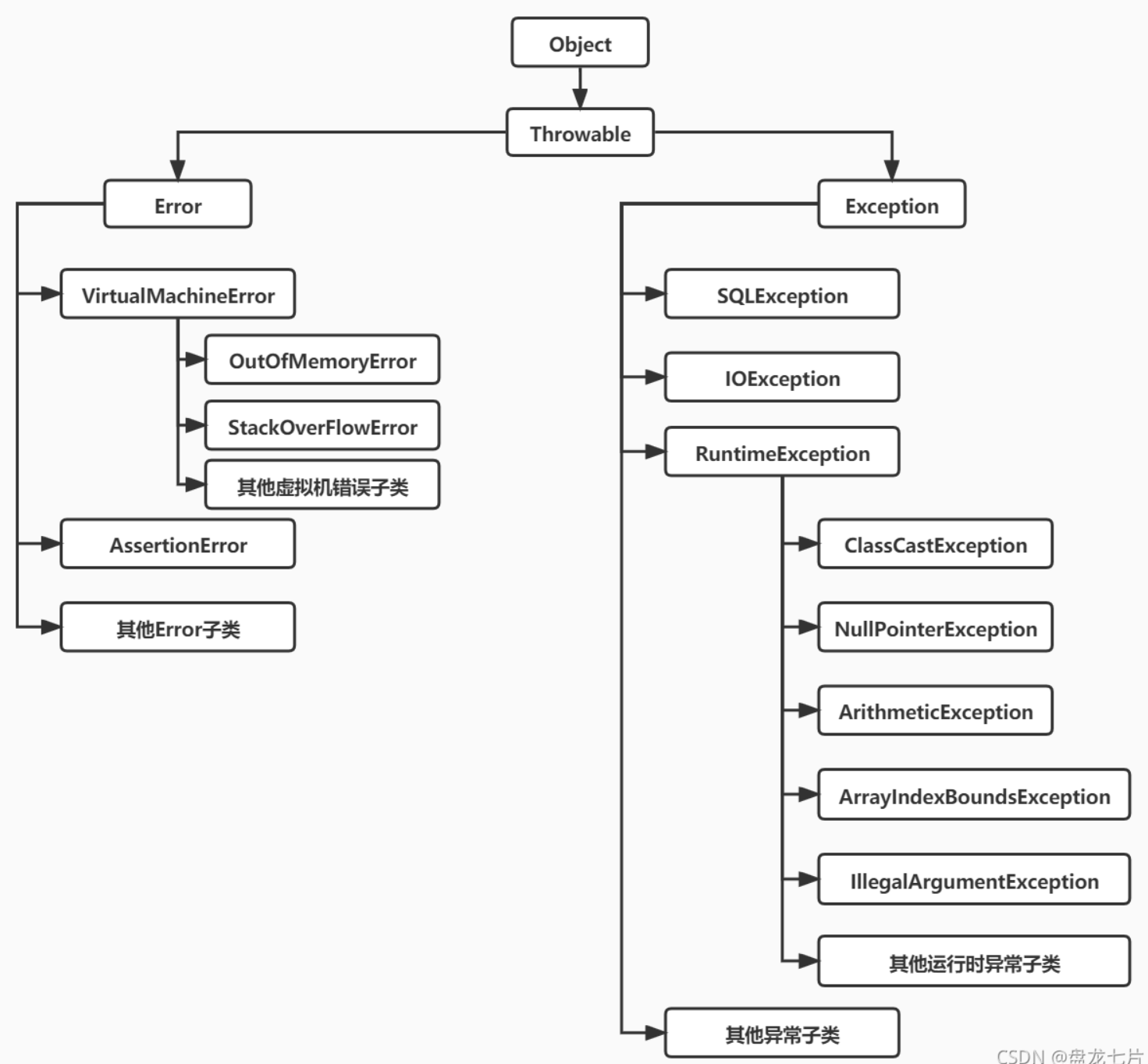Java SE PART 3
Enumeration
Section titled “Enumeration”通过自定义类实现
- 构造器私有化
- 本类内创建一组对象
- 对外暴露对象,可以通过
public final static修饰符实现 - 可以提供 get 方法,但是不要提供 set
class Season { private String name; private String desc; //构造器私有化,防止New //去掉Set方法,防止属性被修改 //在Season内部,直接创建固定的对象 private Season(String name, String desc) { this.name = name; this.desc = desc; }
public final static Season SPRING = new Season("春天","温暖"); public final static Season WINTER = new Season("冬天","寒冷");}
class Enumeration { public static void main(String[] args) { System.out.println(Season.SPRING); }}通过 enum关键字实现
- 常量写在最前面,用
,分隔,最后以;结尾 - 如果调用无参构造器创建枚举对象,可以省略小括号
enum Season { SPRING("Spring","Warm"),SUMMER("summer","hot"),AUTUMU("fall","cool"),WINTER("winter","cold"); private String name; private String desc; private Season(String name, String desc) { this.name = name; this.desc = desc; }}
class Enumeration { public static void main(String[] args) { System.out.println(Season.SPRING); }}$ javap Season.classCompiled from "Main.java"final class Season extends java.lang.Enum<Season> { public static final Season SPRING; public static final Season SUMMER; java.lang.String name; java.lang.String desc; public static Season[] values(); public static Season valueOf(java.lang.String); static {};}Enumeration Method
Section titled “Enumeration Method”public class Main { public static void main(String[] args) { Season summer = Season.SUMMER; System.out.println(summer.name()); //SUMMER System.out.println(summer.ordinal()); //输出元素的下标,从0开始,此处输出1 System.out.println(Season.SPRING.compareTo(Season.SUMMER));//SPRING下标 - SUMMER下标 System.out.println("================================"); System.out.println(Season.values()); //Season.values()返回Season的元素数组 for (Season season : Season.values()) { System.out.println(season); } System.out.println(Season.valueOf("SPRING"));//如果有SPRING则返回SPRING,没有则报异常 }}-
使用
enum关键字后,就不能继承其他类了,因为enum隐式继承了Enum,而 Java 是单继承机制 -
枚举类和普通类一样,可以实现接口,如下形式
enum 类名 implements Interface1,Interface2 {}
interface IPlaying { public void playing();}
enum Music implements IPlaying { CLASSICALMUSIC; @Override public void playing() { System.out.println("Playing Music~"); }}在使用计算机语言进行项目开发的过程中,即使程序员把代码写得尽善尽美,在系统的运行过程中仍然会遇到一些问题,因为很多问题不是靠代码能够避免的,比如:客户输入数据的格式,读取文件是否存在,网络是否始终保持通畅等等。
程序运行时,发生的不被期望的事件,它阻止了程序按照程序员的预期正常执行,这就是异常(开发过程中的语法错误和逻辑错误不是异常)。
Java 程序在执行过程中所发生的异常事件可分为两类:
- Error:Java 虚拟机无法解决的严重问题。如:JVM 系统内部错误、资源耗尽等严重情况,一般不编写针对性的代码进行处理;比如:
- StackOverflowError(栈溢出)
- OOM(内存溢出)
- Exception: 其它因编程错误或偶然的外在因素导致的一般性问题,可以使用针对性的代码进行处理。例如:
- 空指针访问
- 试图读取不存在的文件
- 网络连接中断
- 数组角标越界
异常分为两大类:运行时异常和编译时异常.
- 运行时异常,编译器检查不出来。一般是指编程时的逻辑错误,是程序员应该避免其出现的异常;java.lang.RuntimeException 类及它的子类都是运行时异常
- 对于运行时异常,可以不作处理,因为这类异常很普遍,若全处理可能会对程序的可读性和运行效率产生影响
- 编译时异常,是编译器要求必须处置的异常。

RuntimeException
Section titled “RuntimeException”-
NullPointerException 空指针异常 空指针异常是最常见的异常之一,当对一个指向 null 的对象对象进行操作的时候就会报这个异常
String name = null;System.out.println(name);//null//System.out.println(name.length());//运行时出错,程序终止 -
ArithmeticException 数学运算异常 例如一个数除以 0
int c = 10/0; -
ArrayIndexOutOfBoundsException 数组越界异常
int[] arr = {1,2,3};System.out.println(arr[2]); -
ClassCastException 类型转换异常
Object o = 23;//String s = (String) o;//运行时出错,程序终止 -
NumberFormatException 数字转换异常
String number = "23";String number1= "23aabb";//Integer it = Integer.valueOf(number1);//System.out.println(it + 1)
Exception
Section titled “Exception”- IOException 输入输出异常,IOException 一般不会被具体的抛出,取而代之的是其子类,比如文件未找到异常,以到达文件尾异常等。我们假设在不存在的路径下读取一个文件,就会抛出文件不存在异常
- SQLException SQL 异常
- FileNotFoundException 文件不存在
- ClassNotFoundException 类不存在
- EOFException 操作文件,到文件末尾时发生异常
- IllegalArgumentException 参数异常
CustomException
Section titled “CustomException”一般情况下,我们自定义异常是继承 RuntimeException 即把自定义异常做成 运行时异常,好处时,我们可以使用默认的处理机制
class AgeException extends RuntimeException { public AgeException(String message) { super(message); }}
public class CustomException { public static void main(String[] args) { int age = 80; if(!(age >= 18 && age <= 100)) { throw new AgeException("年龄需要在18-100之间"); } }}下面的列表是 Throwable 类的主要方法:
| Method | Introduction |
|---|---|
public String getMessage() | 返回关于发生的异常的详细信息。这个消息在 Throwable类的构造函数中初始化了 |
public Throwable getCasue() | 返回一个 Throwable 对象代表异常的原因 |
public String toString() | 返回此 Throwable 的简单描述 |
public void printStackTrace() | 将此 Throwable 及其回溯打印到标准错误流 |
public StackTraceElement[] getStackTrace() | 返回一个包含堆栈层次的数组。下标为 0的元素代表栈顶,最后一个元素代表方法调用堆栈的栈底 |
public Throwable fillInStackTrace() | 用当前的调用栈层次填充 Throwable 对象栈层次,添加到栈层次任何先前信息中 |
try-catch
Section titled “try-catch”-
监视捕获异常,常用在方法内部,可以将方法内部出现的异常直接捕获处理
-
可以完成异常的处理,使程序继续往下执行
-
catch 不能独立于 try 存在。
-
在 try/catch 后面添加 finally 块并非强制性要求的。
-
try 代码后不能既没 catch 块也没 finally 块。
-
try, catch, finally 块之间不能添加任何代码
-
finally 先于 return,即如果 catch 中有 return,会先执行 finally 块中的代码,再执行 return;
try {int i = 0;}catch(Exception e) {return ++i;//会生成temp = ++i; temp = 1;然后执行fianlly;最后返回temp}fianlly {i = 10;}
try{ // 程序代码}catch(异常类型1 异常的变量名1){ // 程序代码}catch(异常类型2 异常的变量名2){ // 程序代码}catch(异常类型3 异常的变量名3){ // 程序代码}finally:要 try-catch 一起使用,用在后面,无论有什么异常发生,finally 都会被执行(可以运行清理类型等收尾善后性质的语句)
public class test { public static void main(String[] args) { try { int a = 1/0; }catch (Exception e) { System.out.println(e); }finally { System.out.println("finally执行"); } }}//java.lang.ArithmeticException: / by zero//finally执行应用 try-catch 输入一个整数
import java.util.Scanner;
public class test { public static void main(String[] args) { Scanner scanner = new Scanner(System.in); int num; String inputStr = ""; while(true) { System.out.println("请输入一个整数"); inputStr = scanner.next(); try { num = Integer.parseInt(inputStr); break; } catch (NumberFormatException e) { System.out.println("你输入的不是一个整数"); } } System.out.println("你输入的num为" + num); }}throws & throw
Section titled “throws & throw”throws
Section titled “throws”throws 用来在类中捕获异常信息,标明方法可能抛出的异常。说明该方法在运行的时候可能会出现这样的异常,在代码中一定要对相应的异常进行处理。一个方法还可以声明多个异常,用逗号隔开就行了
- 这里的异常是一个 FileNotFoundException 编译异常
- 使用前面讲过的 try-catch-finally
- 使用 throws ,抛出异常,让调用 f2 方法的调用者(方法)处理
- throws 后面的异常类型可以是方法中产生的异常类型,也可以是它的父类异常
- throws 关键字后也可以是 异常列表,即可以抛出多个异常
public class Throws01 { public static void main(String[] args) { public void f2() throws FileNotFoundException,NulPointerException { FileInputStream fis = new FileInputStream("d://aa.txt"); } }}-
对于编译异常,程序中必须处理,比如 try-catch 或者 throws
-
对于运行时异常,程序中如果没有处理,默认就是 throws 的方式处理
class Test{public f1() throws FileNotFoundException {FileInputStream fis = new FileInputStream("d://aa.txt");}public f2() throws ArithmeticException {}public f3() {f1() //error,f1抛出的是编译异常,要么throws,要么catchf2() //ok,f2抛出的是运行异常,不要求程序员显式处理,因为有默认处理机制}} -
子类重写父类的方法时,对抛出异常的规定
-
子类重写的方法,所抛出的异常类型和父类抛出的异常一致
-
为父类抛出的异常的类型的子类型
class Father {public void method() throws RuntimeException{}}class Son {@Overridepublic void method() throws ArithmeticException{}}
-
-
在 throws 过程中,如果有方法 try-catch,就相当于处理异常,就可以不必
当程序发生异常而无法处理的时候,会抛出对应的异常对象。在某些时刻可能会想要自行定义抛出异常,想要自行抛出异常,可以使用 throw 关键字,并生成指定的异常对象抛出。throw 是一个动作,是抛出异常。例如:throw new RuntimeException(),主动抛出异常。
public class test { public static void main(String[] args) { try { int a = 1/0; }catch (Exception e) { System.out.println(e); }finally { System.out.println("finally执行"); } if (true) { throw new RuntimeException("自定义的throw错误"); } }}// java.lang.ArithmeticException: / by zero// finally执行// Exception in thread "main" java.lang.RuntimeException: 自定义的throw错误// at com.xizhicheng.mybatis.test.main(test.java:15)throw vs throws
Section titled “throw vs throws”| 意义 | 位置 | 后面跟的东西 | |
|---|---|---|---|
| throws | 异常处理的一种方式 | 方法声明处 | 异常类型 |
| throw | 手动生成异常对象的关键词 | 方法体中 | 异常对象 |